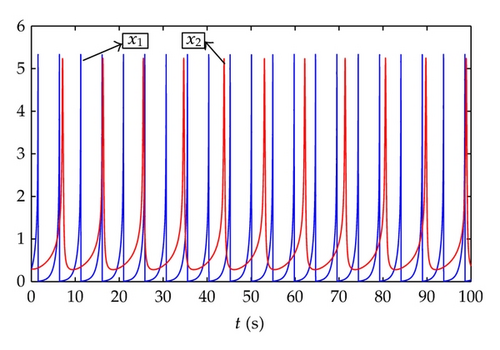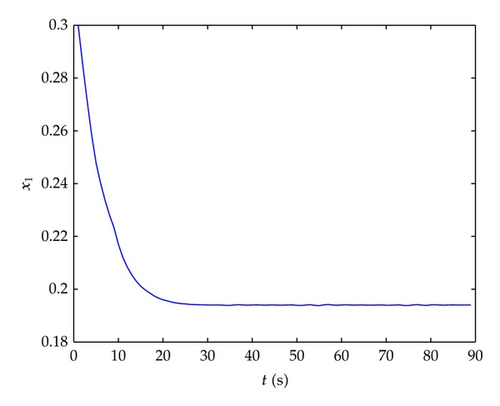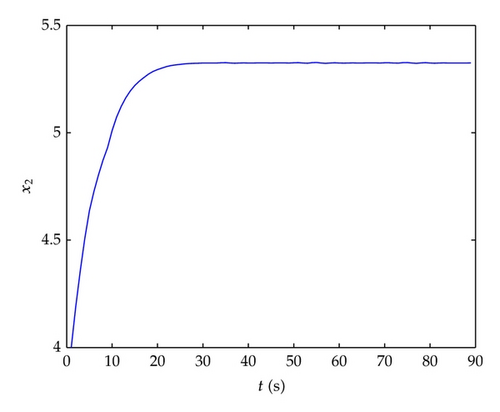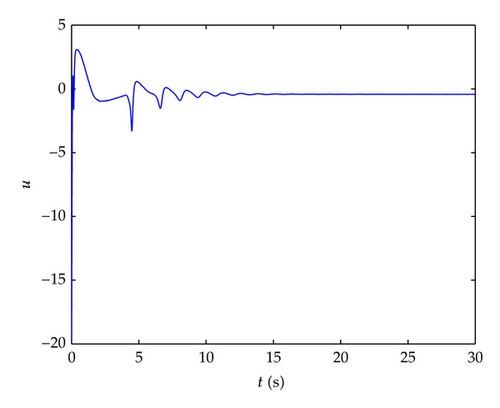The Hybrid Adaptive Control of T-S Fuzzy System Based on Niche
Abstract
Based on the niche characteristics, a hybrid adaptive fuzzy control method with the function of continuous supervisory control is proposed in this paper. Considering the close degree of Niche as the consequent of adaptive T-S fuzzy control system, the hybrid control law is designed by tracking, continuous supervisory, and adaptive compensation. Adaptive compensator is used in the controller to compensate the approximation error of fuzzy logic system and the effect of the external disturbance. The adaptive law of consequent parameters, which is achieved in this paper, embodies system adaptability as biological individual. It is proved that all signals in the closed-loop system are bounded and tracking error converges to zero by Lyapunov stability theory. The effectiveness of the approach is demonstrated by the simulation results.
1. Introduction
In recent years, fuzzy technique has gained rapid development in complex nonlinear plants [1]. Fuzzy logic offers human reasoning capabilities to capture nonlinearities and uncertainties, which cannot be described by precise mathematical models. Theoretical proofs of fuzzy models as universal approximators have been presented in the last decade [2, 3]. Fuzzy adaptive control methodologies have emerged in recent years as promising ways to approach nonlinear control problems. Fuzzy control, in particular, has had an impact in the control community because of the simple approach it provides to use heuristic control knowledge for nonlinear control problems. Recently, fuzzy systems have aroused a great resurgence of interest from part of the control community on the ground that they may be applied to model ill-defined complex systems. Direct and indirect schemes are two staple configurations for adaptive fuzzy controls. It has been established that indirect and direct controls (DAFC and IAFC) are able to incorporate plant knowledge and control knowledge, respectively, to yield stable and robust control systems [4]. The last two decades or so have witnessed a large quantity of results on indirect [5, 6] or direct [7–11] adaptive control (IAC/DAC) using fuzzy systems. However, the fuzzy adaptive controller proposed in [6, 7] ensure that the tracking error asymptotically convergence to zero (or a neighborhood of the origin) if the minimum approximation error is squared integrable along the state trajectory. And those algorithms are just confined to the linear and nonlinear systems whose state variables are assumed to be available for measurement. In many complicated cases, all state variables are not measurable such that output feedback or observer-based adaptive control techniques have to be applied. In [12–15], observer-based IAC and DAC algorithms are proposed for nonlinear systems, respectively. But [6, 12, 13] proposed adaptive control gain is only applicable to nonlinear systems with unknown constant gain. So a hybrid adaptive fuzzy control is needed.
In order to exploit the relative advantages of indirect and direct adaptive configurations at the same time, some researchers have developed several hybrid IAC and DAC algorithms [16–18] where a weighting factor, which can be adjusted by the tradeoff between knowledge of the plant and knowledge of the control, is adopted to sum together the control efforts from both the IAC and DAC. However, those schemes have their limitations. Above all, they take full-state feedback, which can be unsuitable for nonlinear systems without state variables available. Moreover, the conventional adaptive controller proposed in [19] combines indirect, direct, and variable structure methods; nonetheless its plants are assumed to be linear systems only. The author of [6] has developed a hybrid adaptive fuzzy control (HAFC) for nonlinear systems. However, input gains are required to be a constant 1 and control gain is an unknown constant. The HAFC algorithm of [20] can just be applied to robot manipulators with bounds estimation whereas that of [21] derives an unsupported HAFC scheme from a faulty Lyapunov derivative. On the other hand, a certain observer-based combined direct and indirect adaptive fuzzy neural controller is developed in [22]. Sensor fault may be in any form, even unbounded, which will make the system failure unavoidably. Paper [23] proposed a reliable observer-based controller, which makes the system work well no matter whether sensor faults occur or not.
Among various kinds of fuzzy models, there is a very important class of Takagi-Sugeno (T-S) fuzzy models [24] which have recently gained much popularity because of their special rule consequent structure and success in a functional approximation [6, 25]. In the recent two years, with the stability theory of T-S fuzzy system drawing lots of researchers attention, Yeh et al. [25] proposed stability analysis of interconnected and robustness design of time-delay fuzzy systems using fuzzy Lyapunov method. Moreover, T-S fuzzy model plays an important role in dealing with practical problems, such as oceanic structure [26], Vehicle occupant classification [27], and engineering systems [28], in which T-S fuzzy systems are applied to sensor fault estimation.
Upon all the fuzzy control method mentioned above, the consequent rules only contain the mathematical expressions without the practical significances. In this paper, the self-adaptability of the ecosystem is introduced into the fuzzy control method. Ecosystem is a complex large system, the interaction between individuals within the system, the interaction between the system and the outside world, made the internal dynamics of ecological system extremely complex. Biological evolution in complex ecosystems displays a strong nonlinearity [29], and increasing complexity is an indication of biological evolution, which makes it easier for organisms to adapt to environmental changes, and higher adaptability is the performance of a higher degree of evolution, that is, the so-called “survival of the fittest” [30]. Because of the redundancy and stability of ecological system, individuals acquire their own living ability and evolve to the advantage direction. This is why the ecological system could keep balance. The stability of the system is closely related with individuals’ ecological niche. Through such feature, Wang and Yi-min [31] discussed a method of fuzzy control based on niche model. The basic concept and methods of niche are introduced. Using the similarity measures, the capabilities of the living’s self-learning and self-organization are joined in fuzzy system, gaining the fuzzy system which has the meaning of niche. Considering the high-order nonlinearity, complexity, and biological individuals’ adaptability of ecological systems, we combine biological characteristics with adaptive fuzzy control method and raise a new hybrid T-S fuzzy adaptive control way, which contains great biological significance itself. The consequent of fuzzy system is parameter’s ecological niche close degree functions for T-S model. In condition of immeasurable biological individuals’ ecological factors, in [18, 30], the author designs controller and obtains adaptive law with consequent parameter which takes good tracking effect to changing error target function. Fuzzy T-S system of ecological niche reflects the degree of biological exploiting and usage and develops to its favorable way. During this course, the system moves forward by mutual changes, coordination with environment and themselves. This fuzzy adaptive control of niche reflects that the biology of individual organisms in the new environment has a strong adaptability, strong in the biological and practical significance, but also provided a reference value for the artificial cultivation of rare species. Therefore, fuzzy control background gets its biological meaning in this way.
2. Problem Formulation
3. T-S Fuzzy System Based on Niche
3.1. Description of T-S Fuzzy System Based on Niche
3.2. Niche T-S Model Parameter Optimization Method
Niche fuzzy T-S model based on parameter optimization of backpropagation algorithm known input and output data , the task is to determine the form (3.2) Niche T-S model parameters, To fitting error the minimum. Assume M is known, by adjusting , and let ep be the minimum. To facilitate the discussion, use to represent , and . , .
4. Hybrid Controller with Supervisory and Compensation Control Scheme
5. Hybrid Adaptive Control of Niche
In order to design us so that , we need the following assumption.
Assumption 5.1. We could find three functions as fu(X), gu(X), gl(X) and get and , in which X ∈ Uc and . This is due to the fact that we can choose kc to let . Also external disturbance is bounded. We design |d(t)| ≤ dm.
6. Design of Adaptive Law
Applying us we have .
Design parameters of, vector adaptive law of θf, θg, θD, stability, and performance analysis are similar to those of [18]; here we omit it.
7. Simulation

In order to reach an ideal ecologic balance in this two-dimension predators system, we get a way to control it, where .



From the simulation figures, we can see that the prey and predator numbers reach a stable status in a short period of time under the control of the proposed method in this paper. The creature individuals show a characteristic of self-adaptation according to outside changes.
From the figure of the trend of the T-S controller, it also reaches an ideal status to maintain the overall balance of the two-dimension predator system. The ecological system is optimized with the use of this control method.
8. Conclusion
For the ecological niche, a hybrid adaptive fuzzy control method with the function of continuous supervisory control is proposed in this paper. Let the close degree of Niche which contains parameters as the consequent of adaptive T-S fuzzy control system, then designs the hybrid control law by tracking, continuous supervisory and adaptive compensation. Using gradient descent to optimize the parameters, we get the adaptive law of consequent parameters, embodying biological individual’s ability of adaptability. Based on Lyapunov stability theory, it is proved that all signals in the closed-loop system are bounded and tracking error converges to zero. This paper shows that the fuzzy methods provide good results in practical engineering problems. The performance of the developed approach is illustrated by simulation, on two-dimension predation system model.
Acknowledgment
Work supported by national science foundation (11072090).




